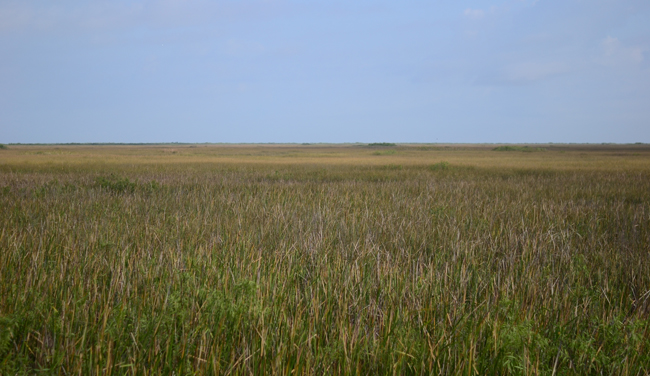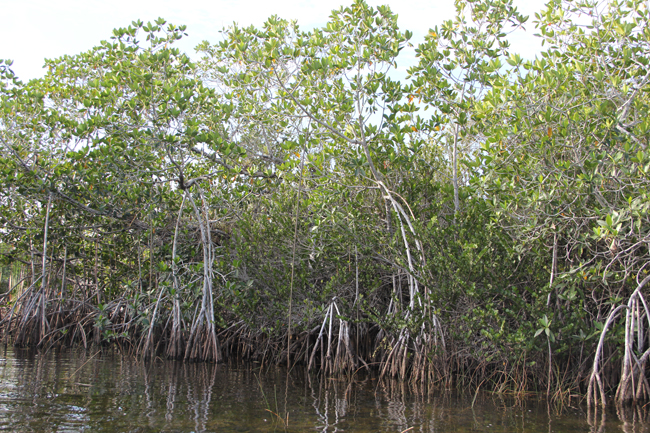The Everglades — Slip Sliding Away
By Maschal Mohiuddin
Known as the most endangered national park in the nation, the Everglades face a great battle ahead. Climate change and the rising sea level in South Florida threaten to completely destroy this national treasure by the end of the century.
“The Everglades is sinking, and we want to stop it,” said Linda Friar, public information officer at Everglades National Park.
Global sea levels are projected to rise during the 21st century at a greater rate than in the past fifty years, according to the Intergovernmental Panel on Climate Change. In fact, the sea level in South Florida could rise almost 20 inches above its 1990 level by the year 2100.
“Almost 60 percent of the Everglades are less than three feet above sea level,” said Stephen Davis, wetland ecologist at the Everglades Foundation. This calls into question the future survival of the Everglades.

Photo by Marvin Williams
A number of measures are currently being taken in an effort to slow down the hazards facing this country’s most esteemed natural habitat. On a national level, the $8 billion Everglades restoration project begun in 2000 is the most significant effort in restoring fresh water flow and reducing the effects of climate change in the Everglades. In addition, other research is underway such as the Everglades Foundation efforts to better understand the effects of salt-water intrusion from the sea level rising. Finally, such natural barriers as new groves of mangrove trees provide may help block the rising tides and salt water.
“It’s about buying time,” said Larry Perez, science communication outreach specialist for the National Park Service in South Florida. “I’m optimistic that we can figure this out by reducing carbon emission and copulating large scale adaptation strategies, but only if we can give it enough time.”
South Florida has one of the fastest growing populations in United States, where almost a thousand people move in everyday. With this increase in population and millions of people annually vacationing in the state, reduced flow of freshwater into the Everglades cannot combat the salt water penetrating inward from the rising sea.
“It is not just a rise in sea level, but the increasing risk from storm surges and astronomical tidal events that results in flooding,” said Davis.
Davis said that this is already happening today. Miami Beach is regularly flooded by high tides due to the lunar cycle. Furthermore, tides can get extremely high and in some cases come up through storm water systems and flood the streets.
“What super storm Sandy did to the Northeast region was reflective of this increasing risk,” said Davis.
Restoring freshwater flow is the key to slowing the transitions that take place from the rising ocean and allow habitats to move more naturally along the landscape, according to Davis.
The Everglades are largely affected by the dangerous salt-water intrusion from high tides. As sea level goes up, there is a landward migration of habitats. Areas vulnerable to salt water will retreat back into freshwater areas, which is the preferential habitat. Plants and animals in the Everglades that prefer to live in brackish areas withdraw when their home is taken away, causing upland shift of habitat. Davis credits the acceleration of this process to reduced freshwater flow.
Some plants and animals can’t adapt to the changes, according to Perez.
“They [wildlife] have a hard time so we have to make a decision to either let them go or use extreme action to save them,” said Perez.
There are other factors and impacts stemming from a higher ocean.
By keeping the area in fresh water as opposed to salt water, sinking of the Everglades can be reduced, according to Friar. However, the stability of the soil has a direct correlation to the sea level rising.
Davis says soil dictates the elevation of the landscape and in some areas there is rapid loss of elevation from salt-water intrusion.
“That collapse [of soil] may short circuit the landward migration of habitats,” said Davis. “It dictates the future coastline in South Florida.”
Davis compared the soil breakdown of the Everglades to land subsidence in coastal Louisiana. He stressed that land sinking in Louisiana has resulted in accelerated sea level rising, an example for Florida to take notice.
“We are focused on this issue because it might prevent landward migration of communities and loss of species and habitat,” said Davis.
Davis explains a list of preliminary experiments that are currently being conducted by the Everglades Foundation to further study this issue. “Our goal is to inform managers in the park about what the future coastline of the Everglades might look like with and without the restoration of freshwater flow,” said Davis.
The issue is important, because as Davis noted, “Unlike coastal Louisiana and the Netherlands, Florida is not equipped to live below sea level.”
These two locations have pumps that actively move water that accumulates below ground to prevent flooding. South Florida sits upon a porous limestone rock, and therefore as sea level rises, water comes both from underneath as well as over ground. Davis points out the challenge in how to manage this issue long term.
South Florida’s limestone also prevents certain mitigation practices, such as sea walls. Perez said sea walls couldn’t be utilized to prevent the salt-water intrusion underground because the water would seep through.
Much of the $8 billion Everglades restoration effort is aimed at getting more water to the southern Everglades. “We should redirect water southward to recharge aquifers and meet sea level head on along the coast,” said Perez. “It will counteract the affect of sea level rise over time.”
Although the effect of future sea level rise on the Everglades is threatening, the freshwater Everglades are separated from the sea by a broad ring of mangroves. The roots of these mangrove trees build a think layer that creates a dike against the sea. This serves as a natural barrier against sea level rising, if the trees continue to grow with the changing landscape.
Over the past fifty years, salt tolerant mangroves have moved inland by two kilometers, according to Perez. If the rate of sea level rising outpaces the growth of the mangrove trees or if these trees are damaged by high tides and hurricanes, much of the natural Everglades may disappear during the next 100 years.

Photo by Kaitlyn Carroll
“There may be a time where the Everglades National Park has no ‘Everglades’ within it because all the fresh water is squeezed out,” said Perez.
The National Park Service has created a Climate Change Response Strategy to address these increasing concerns. Strategies range from reducing the park service’s carbon footprint to increase education about climate change.
“Climate change will impact the Everglades in many different ways, not just sea level rise but changes to weather patterns and drought,” said Friar. “We should be doing everything we can to prevent this.”
Perez describes the Everglades today as significantly different than the one a hundred years ago.
“It is a place of beauty and inspiration despite whatever form it takes in the future,” said Perez. “People will still find value in the Everglades.”